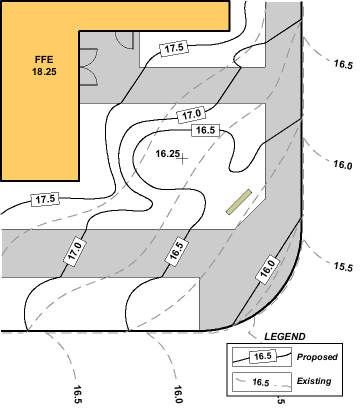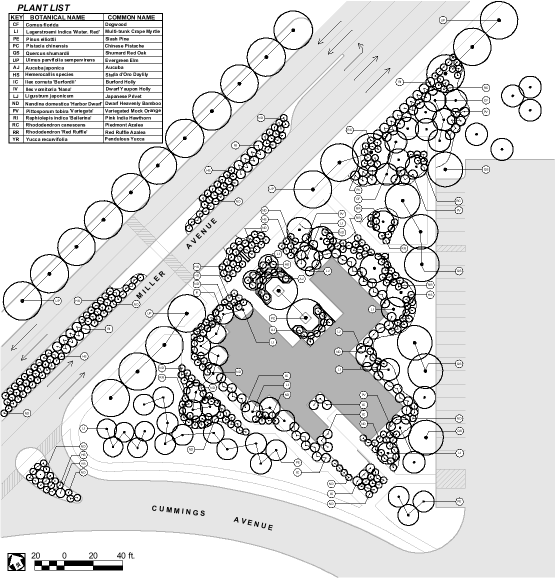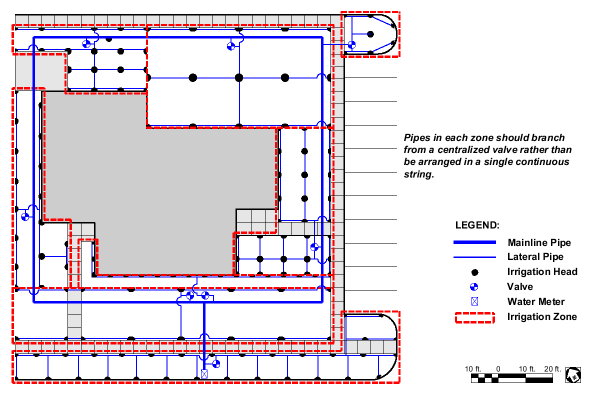![]()
![]()
![]()
This chapter describes the construction documents associated with the installation landscape program.
There are three main elements of the implementation phase: construction documents, post-construction project establishment procedures, and construction management.
Many projects will be built on sites with existing features or elements that are not part of the final design. These elements must be removed or demolished and are shown on the demolition plan.
When project grading requirements are extensive, there may be a need for a grading plan. The grading plan is used to delineate elevations and drainage patterns. The final grading plan shows the site boundaries, existing landform contours with a benchmark to indicate the base for the elevations shown, existing site features, and proposed site structures.
Coordination with other design professionals on final elevations of structures, storm drains, and culverts is often necessary to ensure project success.

Figure 1-25: Grading Plan Example
The planting plan is the essential element of the landscape construction package. The planting plan shows the location and types of proposed plant material in the project as noted in the plant schedule. The plant schedule contains the following information:
Planting Plan Elements

Figure 1-26: Planting Plan Example
An irrigation plan is a schematic representation of the equipment and materials necessary to efficiently provide water to plant material and turfgrass. Standardized symbols should be used to depict irrigation elements. They should be listed and described in an irrigation schedule or legend as well as cross-referenced to the appropriate irrigation details.
Regional climatic conditions influence the requirement for an irrigation system. The designer must determine if the short-term construction costs and the long-term maintenance costs of the irrigation system are justified. If the planting plan is complex, or the project is highly visible and important to the perceived aesthetic quality of the installation, then an irrigation system should be part of the project. A properly designed irrigation plan identifies and locates the following irrigation features:
Irrigation Plan Elements

Figure 1-27: Irrigation Plan Example
Landscape details provide specific information to assist the installer and the construction inspector in implementing a landscape project. Construction details for pavements, planting pits, retaining walls, footbridges, irrigation system components, berms, swales, benches, and fences are a few of the landscape elements that normally are detailed. Anything important enough to do right is important enough to detail.
Specifications control the quality and direct the method of construction for a landscape project. Since specifications take precedence over all drawings and notes, they are crucial to the execution of a project. Specifications include technical data to support information contained in the drawings. A landscape project specification package should include precise construction methods, procedures, and quality control standards of work for all elements in the project. Plant material and irrigation system guarantees and warranties should be expressly stated to further ensure construction quality.
A cost estimate is a compilation of costs to complete a landscape project including materials, labor, overhead, and profit. Some installations use the AF Form 3052 for detailing project costs where others have moved to easily-updated computer spread sheet programs. If a cost estimate is not performed early in the design process, problems can arise as the project design nears completion.
An estimate should be performed at each phase of the design, from the initial budgeting at the programming phase to the final contract or construction package.
An equitable portion of the total project cost must be assigned to the landscape elements and site development. Listed below are typical landscape elements that require cost estimates:
Landscape Cost Estimate Elements
How a landscape project is established is important with respect to long-term results. Whether the project is constructed with in-house personnel or by contract, establishment procedures are the designer's quality guarantee.
Establishment specifications ensure proper installation of plant material, irrigation equipment, turf areas, and other project elements by requiring specific and constant attention to the project landscape elements immediately after installation. Since a large percentage of plant loss and irrigation system failure occurs in the first year, establishment specifications greatly increase long-term project success.
Oversight by a landscape architect of a landscape project is all too often considered a luxury which cannot be accomplished due to lack of funds. The quality and ultimate success of the final product can be improved by involving the design professionals who best understand the project intent and requirements. Many decisions made during the construction of a project impact the intent of the design. By communicating the vital aspects of the design package to the contract manager as well as the contracting officer, the designer can ensure design continuity and success.
Many contractors will request the assistance of the designer in the layout of berms, plants, boulders, and walkways. This does not preclude the need for accurate and well-drawn plans, nor does it relieve the contractor of their contract responsibilities.
![]()
Preceding page | Back to Topic Outline
|
|